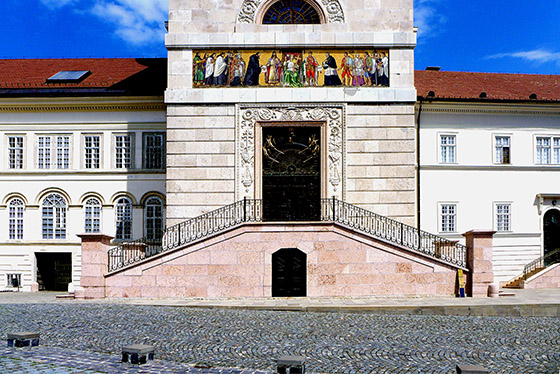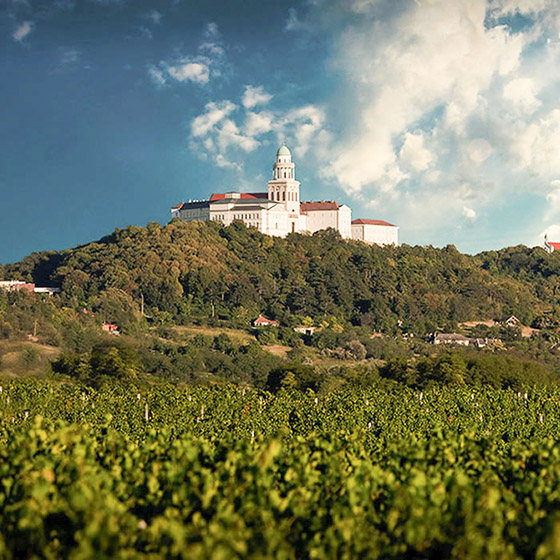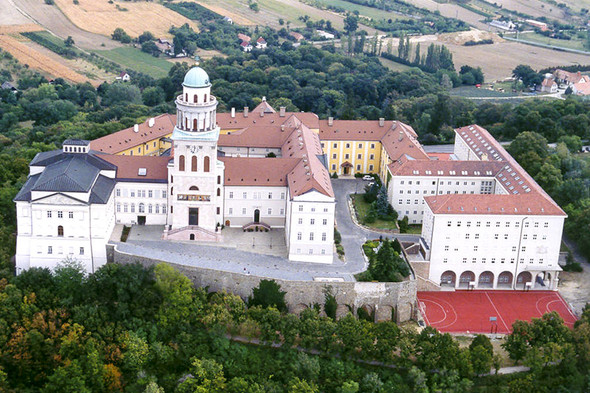Once upon a time, on the southern slopes of the fairy mountain there was a beautiful vineyard. And then came the Turks and phylloxera. The Lord has given, and the Lord has taken away. But finally came reconstruction along with an enterprising Archabbot who filled the new idea with life.
For sure, we could have picked another place and other times for departure instead of the moment when cackling geese betrayed the newly elected Bishop of Tours, St. Martin, the patron saint of France. But let’s leave this story to the sad geese and the merry diners on St. Martin’s day. According to the legend Saint Martin was born at the feet of the Pannonhalma mountain (although calling this elevation of 280m in height a mountain may sound an exaggeration, maybe you will forgive us, dear reader, considering that it is about Szent Márton-hegy, the saint mountain of Pannonia). Although it is clear that legends are easy to disprove and today we are sure that St. Martin was born in what is now Szombathely, yet legends are important to have something to cling to in our fast-paced world without legends and fairy tales.
So, the Benedictine Pannonhalma Archabbey (consecrated in 1002) has been built and improved for a thousand years relying on this fake though wonderfully beautiful legend in an area where already the settler Hungarians found cultivated vineyards. Unfortunately, the name or identity of contemporary winegrowers are unknown but one thing is for sure, Hungarians saved viticulture through the founding of the state. Thus, Benedictines were served with happiness, loads of work and the accompanying sacramental wine at once. Later on, when the Archabbot became the chief landowner of the area, he offered tax advantages to potential investors for establishing further vineyards. It was around that time when the civilians of Győr became an important factor on the Tényő hills.
Death and rebirth
What the Turks could not do, i.e. to ruin and destroy everything entirely, was easily and smoothly completed by the Habsburg in cooperation with phylloxera. The protective tariffs pushed the winegrowers to produce quantities (well before the Soviet planned economy), while phylloxera annihilated the vineyards. Nevertheless, the problems also pinpointed that the abbey functioned as a real innovation centre, considering that well before the national campaign, Benedictines had already been engaged in wine growing in sandy soil and shared the literature with the teachers and priests of the parish so that they should not only preach about the ways of protecting against satanic temptation but about viticulture as well. The upswing was much faster than the national average. In 1920 the abbey was a founding member of National Association of Hungarian Winegrowers and two years later Dutch wine traders were delighted to welcome the tasty wines of Chateau Pannonhalma seeing in them an alternative of the more expensive French wines. By the mid-thirties, the abbey was the chief producer and its aszú wine (yes, the same kind of sweet wine like the Tokaji Aszú), named Bársonyos Gyöngye was the most famous product of the region. And then battles were fought, soldiers marched and died, bombs were dropped and man would never be respected. And the rest is silence

Let’s take a deep breath. We all know what came next. Death and destruction, expropriation, the formation of farmers’ cooperatives, state-coordinated vineyard establishments and classifications and in the end relief and facing bitterly our own past. Yet the abbey seemed to react faster once again. In 2000, the first modern vineyards were established and the foundations for modern wine making were laid down with the help of the late Tibor Gál, a renowned wine maker from Eger. At the same time the abbey has regained its old fame and herb garden, its library was dusted, the marbles polished, a modern restaurant and a visitor centre were constructed, the Benedictine’s medicinal liquor was revived and soon the first lavender chocolate bars and the first wines of the abbey appeared also on the shelves. Today this Benedictine complex is an autonomous universe, a small miracle that is admired also by the Benedictines of neighbouring countries.
One weekend will not be enough
Why would we go today to Pannonhalma instead of Balaton, Mátra, Dunakanyar or Villány? The answer may be surprising but not excessive. Because there are plenty of things to see and to taste. The abbey offers a full day programme to both, those who wish to pray and contemplate and also to those who would like to enjoy and taste delicious foods and then have a nice walk in the neighbourhood. We can buy various items offered by the gift shop to our loved ones and then it is worthwhile that we depart for Győr where not only Audi awaits us, but we can also visit Káptalandomb, the zoo, the Imre Patkó Collection or the Carmelite Church. Or those, who prefer spending their leisure time more actively, can rent a canoe to paddle to Gönyű or they can also take the other direction towards Bakony where mysterious oak forests await the hikers. For Henry IV Paris represented the etalon, but believe us, Pannonhalma is also well worth a Mass or at least the gasoline to go there and an accommodation booked on the internet.

Abbey Winery, Pannonhalma
Pinot Noir Válogatás 2015
This is a high profile “Pannon Pinot” with a serious body and alcohol content, yet with playful acidity and a nice fruitiness. It is well worth having it laid for years before opening it for a festive dinner with a delicious lamb on the menu.
Rajnai Rizling 2015
It was meant to be a fresh Riesling, and the majority was consumed already last summer, however the wine is just beginning to reveal what this variety is capable of. If you can, buy a bottle of this wine and do not open it before 2018.
Hemina red 2015
This red wine will not leave the lovers of Villány or Bordeaux wines disappointed. It’s a mellow wine with serious tannins aged in small barrels. It is worth waiting some years before opening a bottle of this wine as well.
Rosé 2016
It may be a bit more robust and richer than rosés in general. This is due to the fact that only a part of the grape was picked as rosé the rest was added by removing juice upon picking grapes for red wines making, by this, the existing acid backbone mellower.
St. Martinus 2016
The perfect welcome drink. Fragrant and fresh thanks to the Gewürztraminer and Fetească Regală varieties. I could even imagine this wine, properly cooled, for a summer rowing. Making a spritzer of this wine would be a sacrilege.






